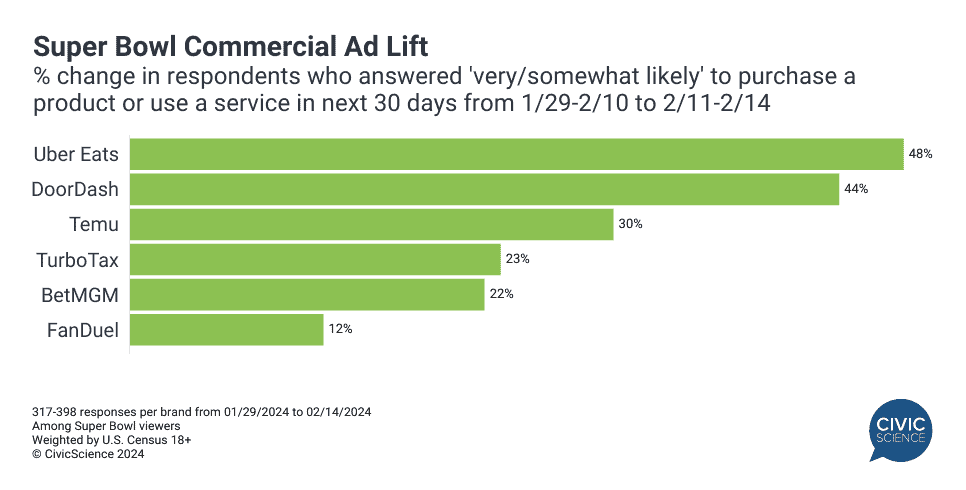CivicScience generates research via the CivicScience InsightStore™, containing over 5 billion consumer responses. Learn how your brand can leverage it here.
The Super Bowl broke TV viewership records over the weekend with an estimated 123.4 million viewers. Thanks to a tight game, a highly anticipated rematch, and Taylor Swift fans, the Super Bowl drew a lot of eyeballs – creating a massive opportunity for the brands airing commercials.
Since Sunday, Americans have been sharing mixed feelings about the commercials. Some viewers think brands played it too safe, but there were still some winners. Others shared complaints over brands like Temu who faced heat post-game.
Answer our Polls: What’s better: The Super Bowl itself or Super Bowl commercials?
CivicScience data show that, in general, the majority of Super Bowl viewers thought this year’s ads were better or worse than last year’s (compared to ‘about the same’). Thirty-six percent thought the commercials were better overall than in previous years, and 26% thought they were worse. Conversely, 38% said they were ‘about the same’ this year.

Super Bowl commercials undoubtedly generate awareness, even among those who don’t tune in or like the ads. CivicScience analyzed how consumer behavior shifted from before to after the Super Bowl – here’s a close look at the brands that won:
Super Bowl Brand Lift
Ongoing CivicScience tracking shows some prominent shifts in intent to purchase a range of brands and services advertised during the event (including the CBS, Paramount+, and Nickelodeon broadcasts). Among Super Bowl viewers, NYX Professional Makeup led the Super Bowl commercials (which featured Cardi B) in terms of brand lift. Compared to data collected the week prior to Super Bowl Sunday, the beauty brand saw a 61% increase in the percentage of viewers ‘very’ or ‘somewhat’ likely to purchase in the next 30 days. Beer brands Michelob Ultra and Budweiser came in second place by a considerable margin with a 42% and 37% increase in purchasing intent.
Conversely, Hellmann’s Mayonnaise (10%), Oreo (8%), and Reese’s (6%) were the bottom three in terms of brand lift.

It’s worth noting, though, that Frito-Lay, Ritz Crackers, and Pringles are the most popular among all the brands in general. Eighty-six percent intend to purchase Frito-Lay chips post-Super Bowl, 80% for Ritz Crackers, and 72% for Pringles.
A close look at services that had Super Bowl commercials shows that Uber Eats (which featured Jennifer Aniston) led the pack for brand lift with a 48% jump in intent to use. DoorDash and Temu followed behind with a 44% and 30% increase.

None of the brands studied saw a negative intent to purchase, hinting that regardless of how good or bad consumers thought they were, Super Bowl ads largely shape consumer intended purchases.
Join the Conversation: Which of the following Super Bowl commercials did you like the most?
Are these brand lifts here to stay?
Consumer attitudes largely shifted post-Super Bowl, but additional CivicScience data points out that consumers had nearly equivalent positive and negative opinions of commercials. Thirty-six percent of viewers said this year’s Super Bowl ads changed their opinion of at least one brand or service in a positive way, just ahead of the 35% who said their perceptions shifted in a negative way.
Commercials that weren’t featured in this study, including Dunkin’ and Paramount+, were also well-received by viewers. A separate CivicScience poll shows that consumers ranked these brands’ commercials as their favorite.
Overall, it’s clear that all Super Bowl commercials made a mark on purchasing intent this year, regardless of whether they liked the ad or not. This is largely reflected in the fact that none of the commercials studied influenced consumer intent in a negative direction.
If you’re interested in tapping into CivicScience’s database of over 5 billion consent-based poll responses and learning about how we can help your ads reach the right audiences, contact us.








